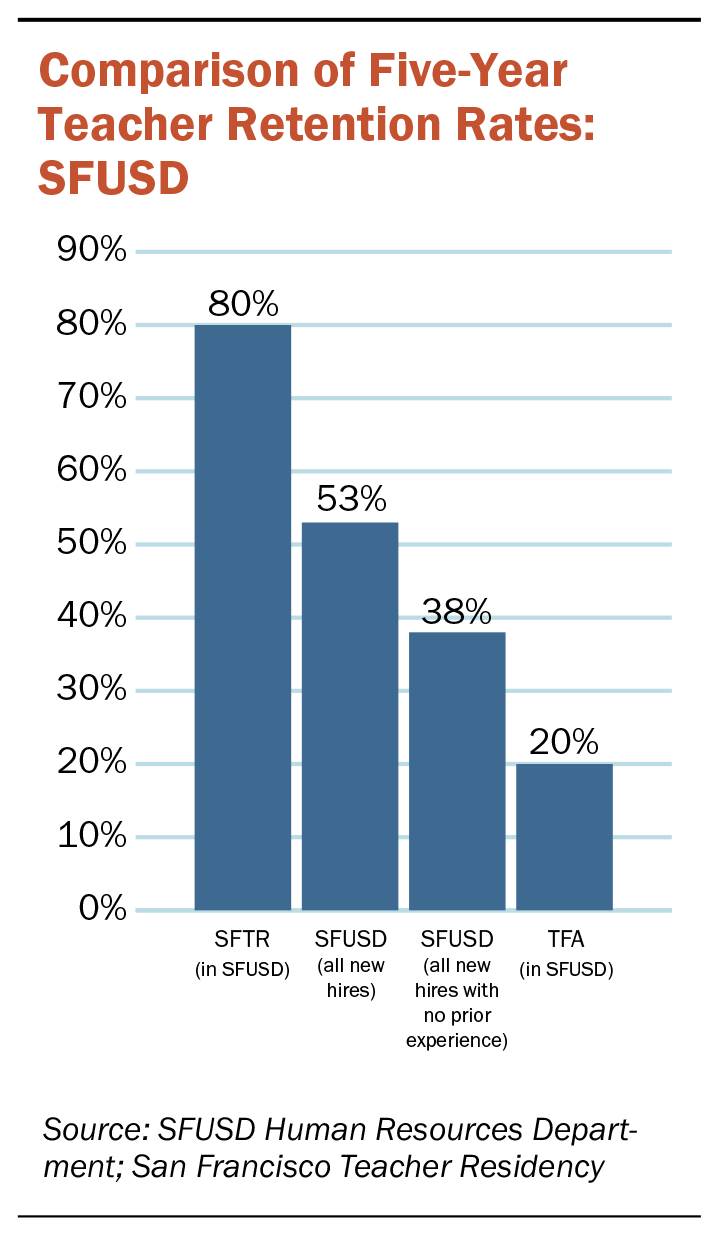Teacher Residencies in California

As teacher shortages are once again becoming widespread in California and across the nation, discussions of how to recruit and retain high-quality teachers are again beginning to take center stage in policy circles. Newly emerging residency programs offer an innovative approach to recruiting and retaining high-quality teachers. These programs:
- Create a vehicle to recruit teachers for high-needs fields and locations,
- Offer recruits strong clinical preparation specifically for the kinds of schools in which they will teach,
- Connect new teachers to early career mentoring that will keep them in the profession, and
- Provide financial incentives that will keep teachers in the districts that have invested in them.

Case Study: A Residency at Work
In 2010, the San Francisco Unified School District (SFUSD) partnered with the University of San Francisco (USF), Stanford University, and United Educators of San Francisco to create the San Francisco Teacher Residency (SFTR). Residents complete a year-long apprenticeship teaching alongside an expert teacher in a high-needs school, while taking courses at night that are tightly integrated with their clinical placement. The 32 residents come together once a week for additional coursework taught by SFTR and SFUSD leaders on topics particularly relevant to district teachers, including implementing restorative justice practices, developing trauma-informed classrooms, and understanding the SFUSD common core curriculum.
As part of the SFTR program, residents also participate in “clinical instructional rounds,” modeled on medical “rounds,” in which they visit classrooms in other schools to observe expert instructional practices, and then debrief with their supervisors. Upon successful completion of the program, residents are guaranteed a job teaching in SFUSD and receive two years of additional intensive coaching and mentoring support—known as induction—from SFTR. As one SFTR graduate observed:
I set up the classroom with my cooperating teacher the week before the first day of school... and I started from the very, very first day of school. I got to see an entire year, five days a week. Just seeing the full year, I knew what to expect, and I felt like I had so much more experience.
The San Francisco Teacher Residency offers a more affordable pathway into teaching for many prospective teachers while providing intensive preparation for the challenges of teaching in a high-needs school. In exchange for a commitment to teach for at least three years in SFUSD, residents receive a 50 percent tuition remission at USF and significant scholarship support and loan forgiveness at Stanford. Residents also receive more than $17,000 in stipends (in part from AmeriCorps), $15,000 in housing grants, and free health care benefits. Many residents identify this strong financial support as a key reason why they chose SFTR over other pathways into teaching.
Mentor teachers are carefully chosen based on a demonstrated track record of successful teaching as well as their interest in mentoring the next generation of teachers. They are provided significant professional learning opportunities through SFTR (with paid substitutes) and a $2,500 stipend. As one SFTR mentor teacher stated:
What I really enjoy about being a mentor teacher is the fact that it doesn’t keep me stale in my teaching. It really keeps me young. It keeps me engaged.
Additionally, building on the professional development school model, SFTR places residents in a small number of “teaching academies.” These schools, which serve primarily low-income students of color, have been identified as “hard to staff” by the district while at the same time having strong leadership and teaching practices. As one principal who has hired multiple SFTR graduates observed:
The residents who are now teaching here definitely have a leg up. They understand the students and the micro-systems we have created to accomplish specific tasks … They know the curriculum, and they usually know the parents ... The kids already know their faces! It would be great if all new teachers could come in with that sort of knowledge, able to start off without being overwhelmed by everything and anything.
Since 2010, SFTR has prepared nearly 150 aspiring teachers to work in high-needs schools within the San Francisco Unified School District. Now in its sixth year, the district’s investment appears to be paying off.Retention data are drawn from materials prepared by the SFUSD Human Resources Department as well as SFTR.Retention data are drawn from materials prepared by the SFUSD Human Resources Department as well as SFTR. Additional data on SFTR’s impact are drawn from http://www.sfteacherresidency.org/impact/, last visited on 1/2/16, including Urban Teacher Residency United, Measuring UTRU Network Program Impact, August 2015.
- SFTR graduates show remarkably high retention rates. After five years, 80 percent of SFTR graduates are still teaching in SFUSD, compared with 38 percent of other beginning teachers hired by SFUSD and 20 percent of Teach for America corps members placed in SFUSD. Of all SFTR graduates over the past five years (including first-, second-, third-, and fourth-year teachers), 97 percent are still teaching, with 89 percent still teaching in SFUSD.
- SFTR grads are helping to diversify the SFUSD teacher workforce. 66 percent of SFTR grads are teachers of color, compared with 49 percent of SFUSD teachers as a whole.
- SFUSD principals say SFTR graduates are more effective than other new teachers. One hundred percent of principals agree that SFTR graduates are more effective than other new teachers from both university-based and alternative route programs.
- Students taught by SFTR graduates have high levels of confidence in their teachers’ competence. On the YouthTruth Student Survey administered to more than 1,700 middle and high school students taught by SFTR graduates, students were especially confident in their teachers’ ability to engage, develop personal relationships, and employ academic rigor, high expectations, and strong instructional methods with them. High school students also rated their teachers as having strong expertise in creating a positive classroom culture.
Teacher Residencies in California is licensed under a Creative Commons Attribution-NonCommercial 4.0 International License.
Research in this area of work is funded in part by the S. D. Bechtel, Jr. Foundation. Core operating support for the Learning Policy Institute is provided by the Ford Foundation, the William and Flora Hewlett Foundation, and the Sandler Foundation.
